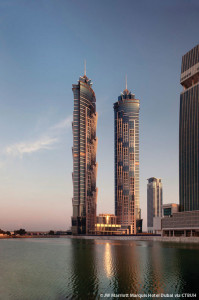Companies Innovate, Offer New Products and Services
Companies involved with tall building construction continue to innovate and grow, and they’re bringing new products and services to their customers. For most companies, business is strong.
At RISA Technologies in Foothill Ranch, California, Vice President, Operations, Amber Freund says, “We continue to hear from engineers that projects are coming in and design work is keeping them busy.” She adds: “With a well-trained team of engineers and software developers, RISA is working to meet the needs of our growing client base by implementing new design features and expanding the suite of software tools that we offer. Providing exceptional customer service is a priority to us, and is something we continue to strive for in our day-to-day operations. We have a wide variety of engineering design experience within the office, which gives us a great perspective for future development goals. Our focus is squarely on our clients.”
Freund notes that the company released RISAFloor ES in 2014 “so RISA now offers everything you need for concrete design.” She adds, “For concrete floors, including beams and two way slabs, nothing beats RISAFloor ES for ease of use and versatility. The design of columns and shear walls with RISA-3D offers total flexibility. Integration between RISA-3D and RISAFloor ES provides a complete building design.”
She says that the company introduced RISAFloor because companies asked for it. “RISAFloor customers had been asking for elevated concrete slab design with the same easy to use interface they were used to. Adding this feature was a good fit and expansion of our design features within RISAFloor.”
Also on the software side, Tekla, Inc. in Kennesaw, Georgia, has launched a new building analysis and design solution in March called Tekla Structural Designer (TSD). “TSD utilizes some of the technologies from previous CSC solutions, Fastrak and Orion,” says Stuart Broome, Engineering Business Manager. “TSD has been developed with BIM integration in mind and enables structural engineers to model, analyze, design and produce drawings for complete buildings in a single interface. Capabilities include: steel, composite and concrete, and it is versatile enough to include floors, complex roof structures such as trusses, slopes, and hangers, as well as gravity and lateral systems all in the same model.”
Broome also says the company had introduced version 21 of Tekla Structures in March, bringing much more drawing capabilities to their BIM solution. “Tekla Structures is well known around the world as being the most widely used and complete solution for steel and concrete detailing, but is less well known as a structural engineer’s tool for producing construction documents and general arrangement drawings. V21 includes many new features to make drawing production quicker than ever before. Because all of the detail is contained in the actual model, there is no need for additional 2D line work. Even dimensions and labels are automatically produced on the drawings. This also makes dealing with changes very quick,” says Broome.
StructurePoint, formerly the Engineering Software Group of the Portland Cement Association (PCA), located in Skokie, Illinois, considers itself “a convenient single point of access to the vast resources and knowledge base of the entire cement and concrete industry including Library services, training, R&D, publications, building codes, specialty engineering, concrete material and testing, concrete repair, codes and standards consulting,” according to Heather Johnson, Marketing Director.
Johnson wants SEs to know about StructurePoint’s release of spMats v8.00, which was issued in the fall of 2014. “It provides foundation designers a sophisticated, brand new finite element solver. This increases capacity and substantially speeds solutions for larger and more complex models such as commercial building foundations, industrial facilities, slabs on grade, and equipment foundations. Also introduced are new results sections, including a report of reaction values for restraints, soil, spring, pile, and slaved nodes.”
She notes: “StructurePoint is now focused on incorporating ACI 318-14 code changes into our software suite. We are very pleased with the new code organization and find its new member based chapters a perfect match to our member design programs. Now there is a code chapter that correlates exactly to spBeam, spSlab, spColumn, spWall, and spMats. Our end users can easily account for all the 318 code provisions directly in their corresponding StructurePoint software output and results.”
Johnson says that they continue to support and gain credibility with international clients along with a definitive expansion in the Middle and Far East. “Meanwhile, our U.S. clients continue to consolidate and refine their software choices by increasing StructurePoint licenses for increasing work in retrofit and occupancy changes. These opportunities can sometimes make for very tough and long days, so we are continuing to add staff to address the consulting and educational projects that are no longer addressed by departments of Portland Cement Association.”
Cast Connex Corporation, headquartered in Toronto, Ontario, works with structural engineers and architects to enable them to incorporate cast steel components into their designs, and then assist contractors successfully integrate Cast Connex products into the structures they construct, according to Carlos de Oliveira, the founding Chief Executive Officer. “In so doing, we simplify the design and enhance the performance of structures. And when we say ‘enhance performance,’ we mean performance in the broadest terms: from architectural to structural performance.”
De Oliveira says that casting manufacturing offers the ability to produce monolithic, high integrity structural steel components of virtually any geometry. “Designers across the United States and the world over are leveraging cast steel components in innovative ways to economically address design challenges and to enable unparalleled architectural design opportunities – enhancing structural performance, improving quality, refining aesthetics, and saving money all at the same time.”
He adds: “Aesthetics aside, castings provide an opportunity to improve connection load path and connected member efficiency. For example, cast joints can be used to eliminate or reduce shear lagging effects in connections, allowing for higher member utilization. Also, given their isotropic material properties, castings are ideal for use at heavily loaded, multi-axis connections. In high rise construction, a common practice is to build up nodes from plates ‘laminated’ to one another. However,” says de Oliveira, “when the loading on built-up nodes is multi-axis and results in the need to transfer load perpendicular to the direction of lamination, the engineering of such built-up nodes can be challenging and fabrication costs dramatically increase. Replacing those complex, built-up joints with castings is ideal. In fact, there are a number of high rises in Asia where this approach has been implemented with great success, and where this use of castings provides a higher degree of confidence in the quality and robustness of the joints. Note, too, that because machining is a standard part of casting production, cast nodes can be produced with machine-level dimensional precision at locations where structural steel elements are to mate with the casting. As such, shop jointing and field fit-up can be improved in projects which leverage castings.”
At CTS Cement Manufacturing Corporation in Cypress, California, Janet Ong Zimmerman, the company’s marketing director, says: “Business is very good. Restoration, tilt-up, and flooring are growing for us and our customers. Residential is still a little slow, but coming back. Engineers, architects, contractors and other construction professionals are turning to innovative products to help solve and simplify their construction needs. For instance, they are looking for products that are fast, strong, durable, and easy to use.”
She suggests that SEs will be interested in their Rapid Set V/O Repair Mix (Vertical Overhead Repair Material). “Damaged concrete, even in vertical or overhead locations, can be dealt with quickly and easily using Rapid Set V/O Repair Mix,” says Zimmerman. “V/O Repair Mix is a high performance, polymer-modified blend of Rapid Set Cement with additives and specially graded fine aggregates, so it bonds well with existing concrete and is freeze/thaw and corrosion resistant. It is ideal where rapid strength gain, high durability, and low shrinkage are desired.”
Zimmerman says: “Use V/O Repair Mix in thicknesses from ½ inch to 6 inches (1.2 to 15.2 cm) for general concrete repair, resurfacing, vertical and overhead applications and mortar beds. It can be applied full-depth with a single coat. V/O Repair Mix sets in 45 minutes and is ready for loading in 2 hours. It does not need to be wet cured in most applications, because it uses a cutting-edge self-curing technology (SCT). The mix is tinted gray to match most Portland concrete surfaces, and can be used indoors or outdoors.”
The impetus for this product came from customers. “We did market research and found a lot of products for patching, but not many products that do what V/O Repair Mix does. V/O Repair Mix is versatile and can be used on different types of projects. It is innovative due to its built-in corrosion inhibitor, fiber reinforced, and self-curing technology. It allows contractors to apply from a very thin to thick application in a single lift, which is rare for this kind of product,” says Zimmerman.
New Millennium Building Systems has developed the Flex-Joist Tension-Controlled Steel Joist design approach, in part to address a growing interest in ways to resolve roof overloading. The approach provides for an overall increase in steel joist strength, reliability, and safety, according to a company spokesperson. “The safety advantage relates to the joist’s ability to flex before it breaks. A Flex-Joist system can be equipped by a third-party sensoring installer to establish an early warning system for roof overloads. This is a ductile tensile yielding design approach that has been well researched. The method was published last spring in the AISC Engineering Journal. Flex-Joist also meets the design requirements of the Steel Joist Institute.”
Company officials see a trend in steel building design and construction around the concept of composite joists. “The approach has been around for many years, but is now more top-of-mind due to the rise in multi-story building construction,” the spokesperson continued. “A composite steel joist achieves a higher density floor structure, compared to more conventional methods. This is achieved by integrating the structural elements into one compact system. Floor-to-floor elevations can be narrowed due to the thinner floors. Mechanical runs can be passed through the open web steel joists, rather than under a solid wide flange beam. Longer spans mean fewer columns and a more space-efficient design. Lighter and fewer joists also mean less cost at every step, including joist erection and joist fireproofing.”▪


